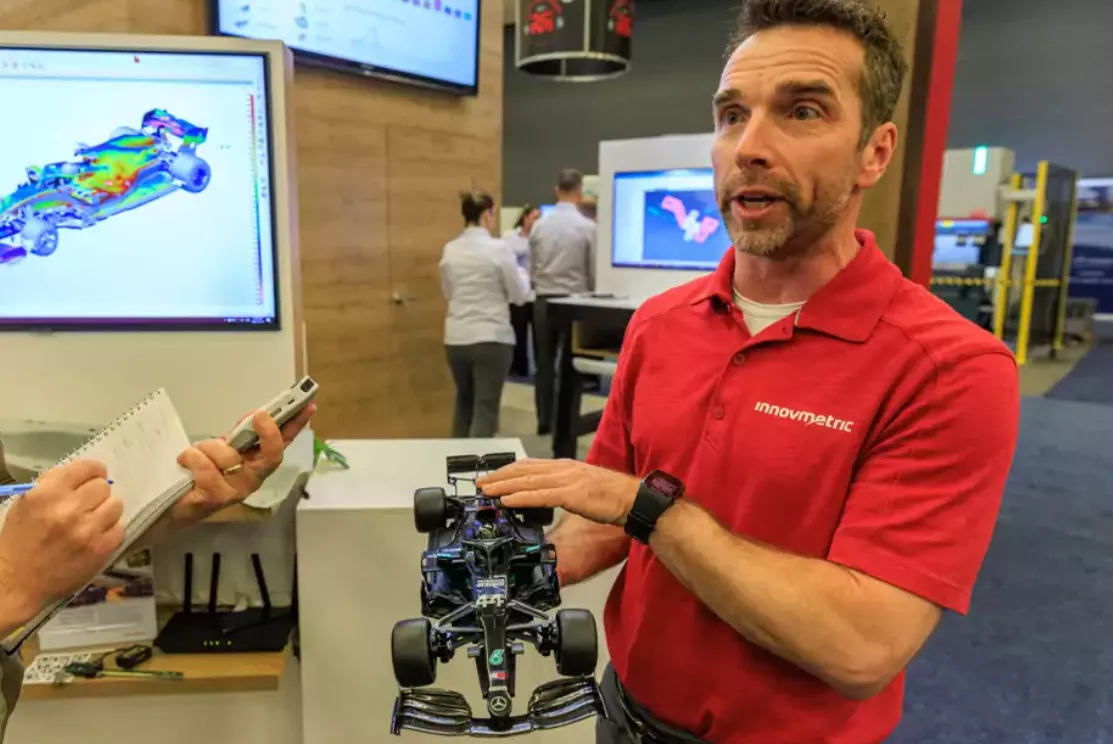Formula 1 Racing Cars Scrutinized Using Quebec Know-How
6/17/22

Jean-Sébastien Blais, engineer and Global Expert – Enterprise Solution Deployment at InnovMetric.
Photo credit, Hugo-Sébastien Aubert, LA PRESSE
Every millimeter counts when you are trying to improve the performance of a single-seater Formula 1 car. To level the playing field between the teams, the Fédération internationale de l’automobile (FIA) has turned to Quebec know-how. Since the start of the racing season, 3D metrology software designed by InnovMetric has scrutinized the cars in minute detail.
Precision work
It isn’t obvious at first glance in the paddocks of the Gilles-Villeneuve racetrack in Montreal, Canada, but behind one of those many garage doors is a compulsory checkpoint for single-seater racing cars. It is here that they are meticulously examined by the team led by Nuria Encinas, F1 Permanent Scrutineer, the watchdog for the enforcement of regulations.
“Our job is to make sure that they [the teams] don’t cheat,” she said in an interview from the paddocks. “If they cheat, it’s because we didn’t do a good job.”
Ms. Encinas offered a guided tour of the area to La Presse.
Traditionally, the FIA used physical templates (customized tools) to manually measure the wings, chassis, ground clearance, and distance between the wheels, to ensure that everything was in compliance.
These differences may be difficult to see with the naked eye, but in the top category of motor sport, cheating by one millimeter can change things when trying to pass your rivals on the racetrack.
“It’s a lot!” says Ms. Encinas.
The current season marks a break with the past. With all the changes in the field of aerodynamics, the FIA decided to put away the physical templates once and for all. The high precision work was entrusted to a laser sensor.
“Each car is different,” explains the FIA’s F1 Permanent Scrutineer. “We couldn’t have a template for every single-seater. Now, anything can be measured using a single 3D measuring device and workflow.”
How does it work?
The FIA adopted the PolyWorks® platform, InnovMetric’s flagship software. Essentially, this software allows one person to perform high-accuracy measuring using a 3D measuring device.
Parked on an elevator, specific dimensions of the single-seater racing cars are measured using numerous spherical reflectors installed in precise locations and a laser tracker. Then, the data is sent to a database to be compared to an approved digital model.
The objective is to ensure that everything is in compliance within five minutes.
“It’s really very simple for the person doing it,” explains Jean-Sébastien Blais, engineer and Global Expert – Enterprise Solution Deployment at InnovMetric. “With a laptop, PolyWorks, and a laser tracker, a single person can take the measurements, and a compliance report is automatically generated, highlighting any failed tests. This is an example of what our platform can do.”
And if changes in regulations occur during the season? No problem, according to Mr. Blais. All one needs to do is adjust the software’s data.
A natural connection
How did the FIA come to choose PolyWorks from InnovMetric?
The Quebec-based company is well-known in the automobile industry. Major automakers already use PolyWorks to ensure that various parts of consumer vehicles, such as doors, comply with their specifications.
InnovMetric says that over 80% of F1 racing teams use their software platform.
“By mastering this technology, when [automakers] have a racing team, such as Ferrari, they can apply it in different ways,” says Mr. Blais. “The FIA realized that in order to be efficient, they needed this type of technology.”
An ongoing apprenticeship
The Canadian Grand Prix is the ninth race of the season. As the owner of a PolyWorks license, the FIA is continuing to fine-tune the PolyWorks software to fit its needs.
Therefore, improvements in measurement and execution are still expected.
“We have to interpret the data and understand how everything works,” emphasizes Ms. Encinas. “For this reason, it’s more complicated, but we can accomplish so much more in terms of verifications.”
InnovMetric deploys a network of subsidiaries and joint ventures operating worldwide. In the event of a problem, PolyWorks specialists are therefore quickly available. In technology, “there are always adjustments to be made,” adds Mr. Blais.
